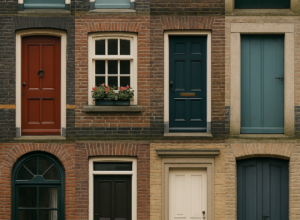Why Netherlands Homes Are Always on Display
In the Netherlands, privacy has a different meaning. While Americans might find it strange at first, the Dutch tradition of keeping curtains open offers fascinating insights into cultural values that shape everyday life in this small but distinctive country.
Walking through a Dutch neighborhood at dusk, you might feel like you’re strolling through a living museum exhibit. As darkness falls and lights flicker on inside homes, windows remain uncovered, offering unobstructed views into living rooms, dining areas, and kitchens. Families eat dinner, couples watch TV, and individuals read books—all seemingly unbothered by the fact that anyone passing by can observe their domestic lives.
If you’re American, this openness might feel jarring at first. After all, in the U.S., drawn curtains and blinds are the norm, not the exception. So what explains this distinctive Dutch approach to domestic transparency? And what can it tell us about Dutch culture more broadly?
Historical Roots of the Open-Curtain Tradition
The Dutch tradition of keeping curtains open dates back centuries and has several historical explanations. During the Calvinist period in the 16th and 17th centuries, displaying an open home demonstrated to neighbors that you had nothing to hide—you were living a virtuous, honest life according to religious principles.
Another theory connects to the Dutch Golden Age, when merchants’ wealth was often displayed through their homes. Windows without coverings allowed passersby to admire expensive furnishings, artwork, and the well-maintained interiors that signified prosperity and good social standing.
Practical considerations also played a role. In a country known for its cloudy, gray weather, maximizing natural light was essential. Keeping curtains open allowed precious daylight to penetrate deeper into narrow Dutch homes, a valuable commodity in pre-electric times.
The Cultural Significance of Open Windows
Today, the tradition continues for reasons that reveal key aspects of Dutch culture:
Social Trust and Transparency
The open-curtain policy reflects the high levels of social trust within Dutch society. When you’re willing to literally display your private life to neighbors and strangers alike, it demonstrates confidence in community safety and cohesion.
This transparency aligns with broader Dutch values of straightforwardness and honesty. Just as the Dutch are known for their directness in communication, their open windows suggest there’s nothing to hide in their personal lives either.
The “Normal” Factor
There’s a Dutch concept that helps explain this phenomenon: “Doe normaal” (act normal). This cultural value emphasizes not drawing excessive attention to yourself or appearing too showy or exceptional.
Paradoxically, keeping your curtains closed without good reason (like sleeping or changing clothes) might suggest you’re doing something unusual or secretive behind them. Being “normal” means participating in the collective transparency.
Pride in Home and Interior Design
The Dutch take enormous pride in their home interiors. From carefully selected furniture to thoughtfully arranged decor, Dutch homes typically reflect considerable attention to aesthetics and comfort. Open curtains allow homeowners to subtly display their design choices and housekeeping standards to the outside world.
This is also why you’ll often see beautiful lamps and lighting fixtures in Dutch front windows. These serve both practical and aesthetic purposes—illuminating the home while creating an inviting glow visible from the street.
What Americans Find Most Surprising
For Americans visiting or moving to the Netherlands, several aspects of this practice often stand out:
The Comfort Level with Being Observed
Most Americans grow up with the idea that privacy means being hidden from view. The Dutch comfort with being observed during everyday activities—eating dinner, watching TV, or having conversations—can seem almost exhibitionist to American sensibilities.
The Absence of Crime Concerns
In many American communities, leaving curtains open after dark would raise immediate security concerns about potential break-ins. The Dutch openness reflects significantly different perceptions about public safety and property crime.
The Collective Nature of the Practice
It’s not just occasional homes with open curtains—it’s nearly everyone. The uniformity of this practice across neighborhoods and social classes demonstrates how deeply embedded this custom is in Dutch social norms.
Navigating Dutch Window Culture as an American
Whether you’re visiting or considering a move to the Netherlands, here’s how to understand and adapt to this cultural difference:
For Visitors
As a tourist, feel free to observe (discreetly) as you pass by—this is considered normal and not invasive, provided you don’t stop and stare intently or take photographs without permission. These quick glimpses into Dutch domestic life can offer authentic cultural insights you won’t find in museums or tourist attractions.
For Potential Residents
If you’re planning to live in the Netherlands, you’ll need to decide how to handle your own window coverings. While nobody will directly confront you about keeping curtains closed, doing so may subtly mark you as an outsider or someone who hasn’t fully integrated into Dutch norms.
Many expats eventually find themselves adapting to Dutch openness, perhaps starting with front-facing windows while maintaining more privacy in bedrooms and bathrooms. It becomes part of the cultural adaptation process.
When Dutch Curtains DO Close
Despite the general openness, there are times when even Dutch curtains close:
- At bedtime (though some Dutch people only close bedroom curtains)
- During hot summer days to keep interiors cool
- When watching television with significant glare
- When changing clothes or engaging in private activities
These exceptions to the rule are contextual and temporary, rather than the default state.
Conclusion
The Dutch open-curtain tradition offers a window into values that set this society apart: transparency, community trust, and the complex balance between privacy and social connection. For Americans accustomed to drawn blinds and tall fences, it represents a fundamentally different approach to the boundary between public and private life.
Next time you find yourself walking through an Amsterdam neighborhood at dusk, take a moment to appreciate these illuminated windows not just as curious cultural differences, but as physical manifestations of a society that has, for centuries, valued openness as a form of social cohesion. It’s a living reminder that concepts we often take for granted—like privacy and home—can take remarkably different forms across cultures.
About What the Dutch is That?
Why are windmills, tulips, and wooden shoes so deeply tied to the Dutch identity? What’s real, what’s myth, and what’s been quietly misunderstood?
What the Dutch is That? is a series that unpacks how certain things became synonymous with the Netherlands—and what they reveal about the people, the land, and the rhythm of life here. Not just symbols, but stories. Not just icons, but origins.








